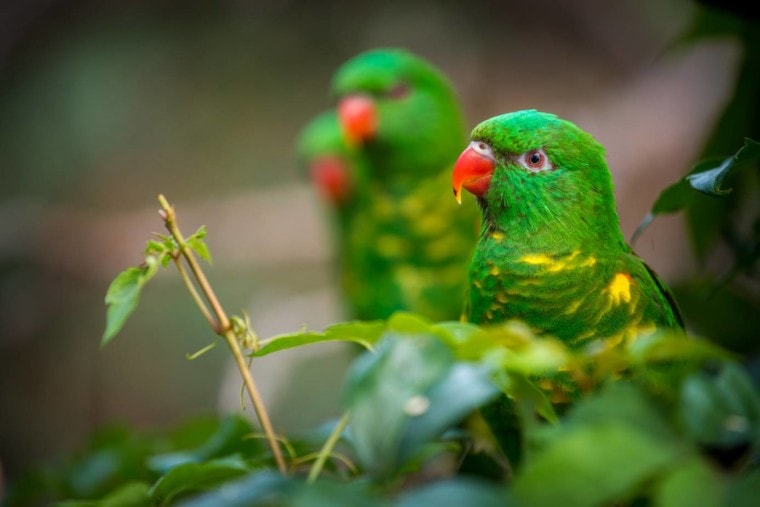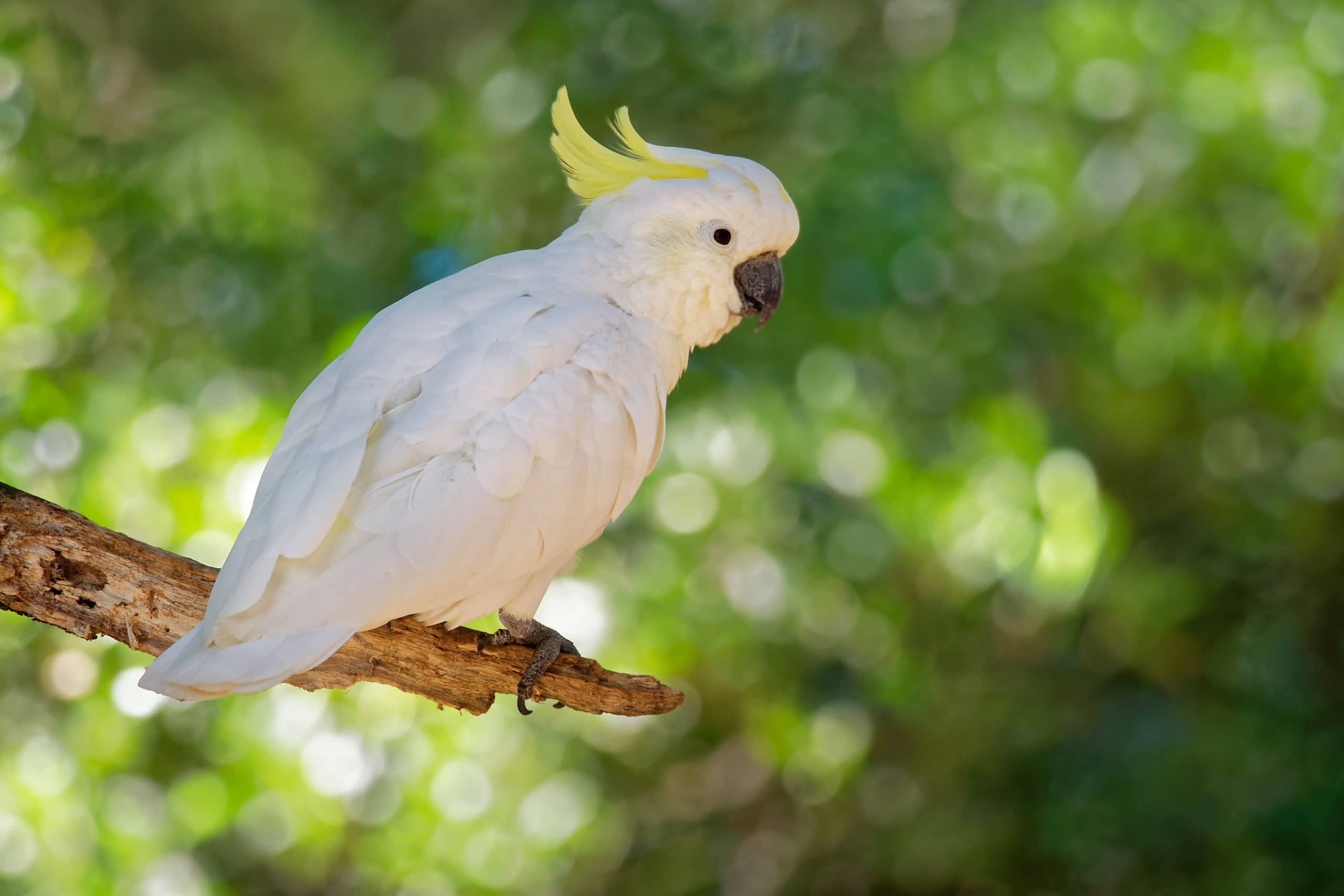
Scaly-Breasted Lorikeets are very popular bird species to own as a pet. These unique parrots are generally small and are known by several names, including Scaly-Breasted Lorikeet, Green Lorikeet, and Yellow Lorikeet.
The Scaly-Breasted Lorikeet is a specific type of Lorikeet that has mostly green plumage with yellow scalloping throughout. They are known for their intelligence, screeching habits, and aggression if bored or threatened.
To learn more about Scaly-Breasted Lorikeets, keep reading. This guide tells you everything you need to know about owning a Scaly-Breasted Lorikeet, ranging from the species history to needed food and diet.
 Species Overview
Species Overview
| Common Names: | Scaly-Breasted Lorikeet, Yellow Lorikeet, Green Lorikeet |
| Scientific Name: | Trichoglossus chlorolepidotus |
| Adult Size: | ~9 inches, 2.6 – 3.3 oz. |
| Life Expectancy: | 7 – 9 years |
Origin and History
Scaly-Breasted Lorikeets are native to Australia. They can be found in both urban and rural areas up the country’s eastern coast. You can begin to see these birds starting at Cape York and ending in New South Wales.
Today, Scaly-Breasted Lorikeets are very popular because of their small size, quirky personalities, and beautiful appearance. Despite being popular pets, they are surprisingly not endangered and are listed as the least of concern on the conservation scale.
However, their numbers are dwindling in Sydney because they are competing against Rainbow Lorikeets for resources. Rainbow Lorikeets tend to be larger than their Scaly-Breasted brethren, which allows the Rainbows to reign supreme.
Temperament
Many people love Lorikeets because they’re really outgoing and quirky. Whenever they’re not flying around, they love screeching to get attention and even whistling to get dogs and other animals to listen up.
Although these birds are quirky and fun, they tend to be much more aggressive than other birds. Scaly-Breasted Lorikeets can especially become territorial and should be housed alone. Their aggression is most likely to come out due to negligence.
Even experienced bird owners find Scaly-Breasted Lorikeets highly demanding because they need a lot of stimulation and companionship, despite their territorial behavior. So, expect to give this bird a lot of time and attention.
If you are willing to put in all the time it requires to care for a Scaly-Breasted Lorikeet, these birds can be really rewarding. They are highly intelligent, which means they can be taught to make certain noises or sounds. Plus, they are quirky and fun to be around, so long as they are comfortable around you.
Speech & Vocalizations
If you are looking for a quiet bird, the Scaly-Breasted Lorikeet is not for you. These birds are known for being very noisy because they love attracting attention by screeching and chattering. They often have metallic and rolling calls, but they are also known for continuous screeching.
Scaly-Breasted Lorikeet Colors and Markings
The Scaly-Breasted Lorikeet comes with a very distinct appearance. The majority of its body has an emerald green color with a slight blue tint. However, the neck, throat, and breast feathers are yellow with broad green edges. This yellow and green breast is why the bird is called the Scaly-Breasted Lorikeet.
Its tail is green, while the base of its outer tail feathers have orange or red markings. As you get to the lower flanks, thighs, and undertail, the green feathers slowly transition to a more yellow coloring.
This bird’s beak really stands out because it is a dark coral-red color that pops off their green face. Similarly, their eyes are typically orange or red, but they are so small that they aren’t as noticeable as the beak.
You can occasionally find Scaly-Breasted Lorikeets with more of a blue, red, or orange coloration, but these birds are very rare because they have a mutation that makes their feathers appear slightly different.
 Caring for the Scaly-Breasted Lorikeet
Caring for the Scaly-Breasted Lorikeet
Although Scaly-Breasted Lorikeets can be a lot of fun, they are a lot of hard work. Expect to spend a lot of time feeding, caring for, entertaining, and cleaning up after this bird. We would only recommend this bird for more experienced owners because of its intense caring needs.

Housing
One of the most difficult parts of caring for a Scaly-Breasted Lorikeet is its housing. Lorikeets are very messy, and they can squirt their feces very far beyond their cage. Yes, you read that right – squirt their feces.
As a result, you want to have a pretty large cage so that the bird can stretch and move around. You will also want to place mats and other cleaning items around the cage to make cleanup just slightly easier for you.
Make sure to clean the Lorikeet’s house frequently. Because of its wet feces, things get really stinky and gross really fast. We recommend placing food containers higher up to avoid contamination. Spot clean once a day and deep clean once a week.
Entertainment
Because Scaly-Breasted Lorikeets are so intelligent, they require high amounts of schedule, activity, and entertainment. We recommend allowing the bird to fly freely in the house for a few hours in the morning to help stretch their wings. Before going to bed, allow them to fly again for a few hours.
Throughout the day, hang out with the bird and provide companionship. Most Lorikeets love to sing along with music and watch TV. You could also find toys and different playthings for the Scaly-Breasted Lorikeet to play with.

Common Health Problems
Like any other pet, take your Scaly-Breasted Lorikeet to an exotic vet once a year for an annual checkup. These birds are experts at masking their diseases, which makes a physical examination by an expert a must.
The most common health problems that Lorikeets face is boredom and mental health issues. Because these birds are so intelligent and not necessarily bred for captivity, they can get bored and depressed very easily.
These Lorikeets can also take on any illness of other birds. If you have other birds in your household, it’s important to keep them separate from one another, especially if one is showing signs of illness or lethargy.
In captivity, Scaly-Breasted Lorikeets can become obese and get diabetes due to overfeeding. Make sure to provide your bird the proper diet and exercise to ensure it maintains a healthy weight.
Diet and Nutrition
Scaly-Breasted Lorikeets eat a primarily liquid diet. They eat nectar and fruits in the wild. In their native habitat, they love to eat acacia and eucalyptus. They sometimes eat grains and seeds in the wild, though they do this seldomly, especially in comparison to other birds.
You want to replicate this diet as best as possible in captivity. Provide fresh vegetables and fruit daily and special Lorikeet food. Offer fresh water every day as well. Most Scaly-Breasted Lorikeets love apples, grapes, carrots, spinach, pineapple, strawberries, and other fruits.
Exercise
The best way to give your scaly crested lorikeet the exercise it needs is to allow it to fly free in your home. For best results, allow free flying exercise in the morning and at night. If you have some way to let the bird fly in an outside enclosure, even better, though this may not be feasible.
If you keep your Lorikeet cooped up in its cage all day, it will become destructive and probably aggressive. These birds love flying around, being active, and playing. Provide mental stimulation while you are away so it doesn’t get bored.
Where to Adopt or Buy a Scaly-Breasted Lorikeet
Scaly-Breasted Lorikeets are considered one of the most popular exotic birds to own as a pet. As a result, they are much easier to find for adoption than some other birds. Many exotic bird stores will offer Scaly-Breasted Lorikeets.
If you do not have an exotic bird shop near you, you can look online instead. There are plenty of aviaries, adoption agencies, and breeders that you can find online.
For further help, you can always ask an exotic vet near you if they have any recommendations for ethical breeders in your area. Most likely, exotic veterinarians will be able to point you in the right direction based on your location. This may be the quickest and most ethical option of all.
No matter where you buy your Scaly-Breasted Lorikeet, make sure to do a thorough examination beforehand. Look for any signs of disease, digestive issues, and lethargy. You do not want to purchase a bird that is dying.
 Conclusion
Conclusion
Scaly-Breasted Lorikeets are super beautiful, quirky, but stubborn birds. They can make a great addition to your home if you are looking for a noisy companion to bring you tons of laughter and sassy responses.
Because of these birds’ aggression and high intelligence, always make sure you can provide it the lifestyle it needs. For one, make sure to get the right housing and diet. After that, provide the bird all of the exercise, attention, mental stimulation, and vet visits it needs to remain healthy.
Featured Image Credit: Jurra8, Shutterstock

 Species Overview
Species Overview Caring for the Scaly-Breasted Lorikeet
Caring for the Scaly-Breasted Lorikeet





